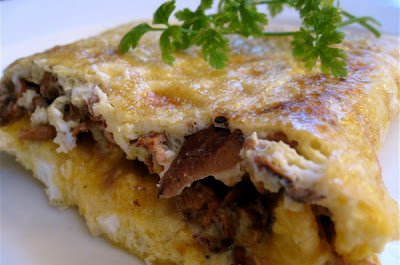
A light dusting of snow on the ground calls for a proper breakfast: Six-egg omelet with Tillamook cheddar and sauteed chanterelles. The chanties, dry-sauteed before freezing in the fall, provided a sweet taste of the Skykomish drainage, which might have augured well for a day of steelhead fishing...but that light dusting in Seattle suggested other pursuits higher still. The way I ski—as a graduate of the Warpo School for Downhill Thrashing—I'm lucky I only broke the eggs today. Check out those sprigs of pale and spotted parsley in the picture above; not happy after being smothered in the white stuff on our back porch.
To be honest, I'm not a huge fan of omelets—in this case it's more of a delivery vehicle for the chanterelles, and after inventorying our freezer the other day it occurred to me that I had better step up the 'shroom consumption or we'll still have this past fall's harvest hanging around next August.
Putting Up Chanterelles
Chanties keep well in the freezer if they're sauteed first and then vacuum-packed. I use two methods of prepping them for storage: The first is the dry-saute, in which the rough-cut chanterelles are added to a red-hot, ungreased skillet. They pop and squeak as soon as they hit the pan and you have to stir constantly so the edges don't burn. The object is to quickly cook out all the moisture for better storage. Dry-sauteed chanterelles are perfect for recipes that don't require much liquid—omelets, stuffings, etc. The other method is what I call the wet-saute for lack of a better name, in which the chanties are lightly sauteed in a generous amount of butter, then frozen in the liquid. Wet-sauteed chanterelles will be gloppy when defrosted, but if used in, say, a pasta cream sauce the difference between wet and dry is negligible.
Next up: Roast Chicken with Chanterelle Stuffing; Farfalle and Chanterelle Casserole (from James Villas' Crazy for Casseroles); and Cream of Chanterelle Soup.

No comments:
Post a Comment